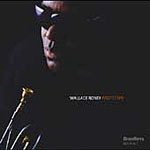Home » Jazz Articles » Album Review » Wallace Roney: Prototype
Wallace Roney: Prototype
Roney's links to Miles Davis have been written about and, perhaps, overexaggerated. There is no doubt that Roney's playing and concept of openness stems from Miles and a time in the late '80s when Roney was hanging with the Prince of Darkness. But whereas Miles changed direction countless times during his career, Roney has chosen a starting point for his music—that of the transitional Miles period of Nefertiti through Filles de Kilimanjaro —and steadfastly evolved the idea, incorporating contemporary technologies and rhythms, painting a picture of where Miles might have gone had he been more evolutionary than revolutionary.
Take "Then and Now," with its "I Got Rhythm" changes. It may start out as the most mainstream-sounding piece on the record, but only for about thirty seconds as it quickly breaks down into a freer piece, with wife Geri Allen peppering the song with abstract harmonies while bassist Matt Garrison and drummer Eric Allen play loose and elastic with the time. But while the track unquestionably fits within the context of the album as a whole, it is something of an anomaly.
"Cyberspace" opens the album with a dark and deep funk groove, Roney and brother Antoine on saxophone stating the attractive yet edgy theme while keyboardist Adam Holzman, who spent time in Miles' late '80s bands, colors the piece with sharp chords and subtle washes. Similarly, "Shadow Dance" finds an expanded horn section building the extended theme over a 3/4 ostinato before heading into more exploratory territory, with guest Don Byron delivering a particularly pungent solo. The title track is a tender ballad, but even though it is one of only two completely acoustic tracks ("Then and Now" being the other), it brings a sense of freedom to the more closely-adhered changes that lends it a consistency with the rest of the record.
It is, in fact, this sense of freedom that pervades the whole record, giving it a sense of urgency. That's not to say this is exactly free jazz; rather it is more open-ended jazz where a firm sense of rhythm exists throughout, but with harmonic and thematic liberation the group is less concerned with hanging on specific changes and, instead, uses harmonic devices as a jumping off point, much as early Weather Report did.
Prototype continues to evolve Roney's conception of jazz, one that successfully combines inarguable roots with a more contemporary view, incorporating a diversity of influences into a blend where the fundamental notion is that of freedom, but, like Miles before him, with a clearly-defined rhythmic and harmonic basis.
Track Listing
1. Cyberspace; 2. Shadow Dance; 3. Prototype; 4. Then And Now; 5. Let's Stay Together; 6. Quadrant; 7. Three Views Of The Blues; 8. Secret Identity.
Personnel
Wallace Roney
trumpetWallace Roney: trumpet; Antoine Roney: saxophones; Geri Allen: piano; Adam Holzman: keyboards; Matthew Garrison: basses; Eric Allen: drums; Clifton Anderson: trombone; Don Byron: clarinet; DJ Logic.
Album information
Title: Prototype | Year Released: 2004 | Record Label: HighNote Records
Comments
Tags
For the Love of Jazz
 All About Jazz has been a pillar of jazz since 1995, championing it as an art form and, more importantly, supporting the musicians who create it. Our enduring commitment has made "AAJ" one of the most culturally important websites of its kind, read by hundreds of thousands of fans, musicians and industry figures every month.
All About Jazz has been a pillar of jazz since 1995, championing it as an art form and, more importantly, supporting the musicians who create it. Our enduring commitment has made "AAJ" one of the most culturally important websites of its kind, read by hundreds of thousands of fans, musicians and industry figures every month.




















